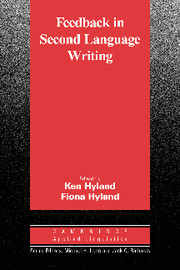Book contents
- Frontmatter
- Contents
- Contributors
- Series editors' preface
- Preface
- Chapter 1 Contexts and issues in feedback on L2 writing: An introduction
- I SITUATING FEEDBACK: SOCIOCULTURAL DIMENSIONS
- II SHAPING FEEDBACK: DELIVERY AND FOCUS DIMENSIONS
- Chapter 5 Does error feedback help student writers? New evidence on the short- and long-term effects of written error correction
- Chapter 6 Electronic feedback and second language writing
- Chapter 7 Resource-rich Web-based feedback: Helping learners become independent writers
- Chapter 8 Feedback in portfolio-based writing courses
- Chapter 9 Students and research: Reflective feedback for I-Search papers
- III NEGOTIATING FEEDBACK: INTERPERSONAL AND INTERACTIONAL DIMENSIONS
- Author index
- Subject index
Chapter 8 - Feedback in portfolio-based writing courses
Published online by Cambridge University Press: 05 October 2012
- Frontmatter
- Contents
- Contributors
- Series editors' preface
- Preface
- Chapter 1 Contexts and issues in feedback on L2 writing: An introduction
- I SITUATING FEEDBACK: SOCIOCULTURAL DIMENSIONS
- II SHAPING FEEDBACK: DELIVERY AND FOCUS DIMENSIONS
- Chapter 5 Does error feedback help student writers? New evidence on the short- and long-term effects of written error correction
- Chapter 6 Electronic feedback and second language writing
- Chapter 7 Resource-rich Web-based feedback: Helping learners become independent writers
- Chapter 8 Feedback in portfolio-based writing courses
- Chapter 9 Students and research: Reflective feedback for I-Search papers
- III NEGOTIATING FEEDBACK: INTERPERSONAL AND INTERACTIONAL DIMENSIONS
- Author index
- Subject index
Summary
Process approaches to the teaching and learning of writing remain popular and convincing. At the same time, portfolios are becoming an accepted tool for demonstrating abilities and performances in key skill areas; portfolio-based assessment of writing is one of the most researched forms of alternative assessment and is now accepted in many different teaching contexts. Writing courses that use a portfolio-based approach to assessment appear to provide a fertile environment in which teachers and learners can engage in feedback on writing and thus mesh well with process approaches.
However, concerns have been raised that a portfolio-based writing course puts assessment at the top of the agenda and therefore colors feedback exchanges with the awareness that this text will be formally assessed (Roehmer et al., 1991). This chapter looks at the effects of a methodology for the teaching and learning of writing that values process approaches, specifically feedback and revision, and that also incorporates assessment by portfolio. By focusing on one case study, I try to understand whether multiple drafting, stimulated by a feedback-privileging teaching and learning environment, results in work that is judged to be better postrevision; and I ask whether teacher-judges working in a portfolio-based assessment at the end of a course oriented to process writing recognize and reward the student's multiple revisions stimulated by the feedback.
Portfolios for assessment and beyond
Portfolio assessment is the best-known and now most popular form of alternative writing assessment (Belanoff & Dickson, 1991; Hamp- Lyons, & Condon, 2000; Yancey & Weiser, 1997).
- Type
- Chapter
- Information
- Feedback in Second Language WritingContexts and Issues, pp. 140 - 161Publisher: Cambridge University PressPrint publication year: 2006
- 19
- Cited by

